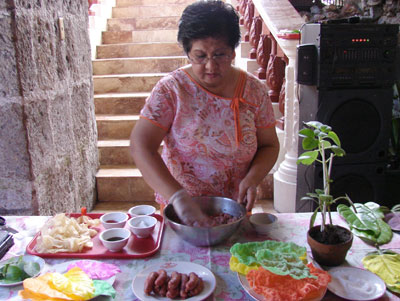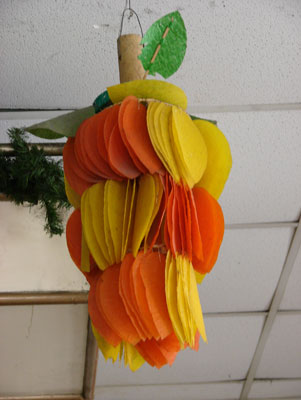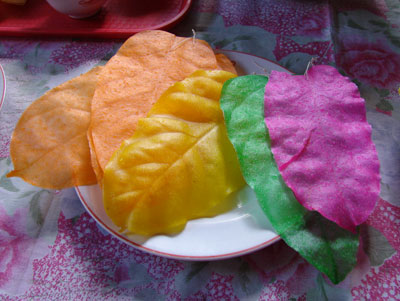What’s Cooking in Quezon Province, Philippines
This item appears on page 65 of the August 2009 issue.
“In April we start making thousands of kiping,” explained Milada Valde of Lucban, Quezon, Philippines, as she poured the bright yellow batter over a large shiny leaf.
Placing the kiping-covered leaf on a steamer, she continued: “May 15 is our Pahiyas Festival. We give thanks to San Isidro Labrador, the patron saint of farmers, for a good harvest by covering our houses completely in fruits, vegetables and decorations made of kiping.”
As she peeled the dried, wafer-like kiping off the leaf, she explained, “We fashion the kiping into elaborate brightly colored flowers, chandeliers and other decorative items. If we bake the kiping, we can eat it, too.”
Kiping are unique to Lucban. Several centuries ago, during the Acapulco trade, a chef returned to Lucban and wanted to make tacos but could not get the necessary ingredients, so he experimented and invented kiping.
During the Pahiyas Festival, competition is intense as homeowners compete for prizes for the best and most creative displays. The streets are packed with locals and visitors to view the procession of colorful floats and giant papier-mâché effigies, including San Isidro Labrador’s image, all to insure bountiful harvests.
While the kiping were drying, Valde demonstrated how generations of her family have been making the town’s other local delicacy, Lucban longganisa. After mixing all the ingredients, she deftly stuffed the mixture into the casings.
“You can tie them off into any length you want,” she said.
The grandmotherly Milada Valde owns Dealo’s Koffee Klatch and fed us pastries along with the Lucban longganisa and the other local specialty, pansit, or fried noodles.
It was March ’08, and Lucban had been the first stop on our daylong culinary tour of Quezon Province. In Tayabas we stopped at a unique restaurant, Kamayan sa Palaisdaan, with tables in thatch-roof bamboo pavilions built over a large fishpond. Diners can catch their own fish, which are then cooked for them.
We watched food being grilled and enjoyed listening to the roving band. Sadly, we were too full to eat again.
We made a quick stop at Kamay ni Hesus, the impressive hillside shrine honoring the Healing Jesus. The steep, landscaped hill tells the way of the cross, with the Last Supper tableau near the bottom and the crucifixion at the top.
Our last stop was the resort Graceland, a beautifully landscaped property located in Tayabas. And, yes, the owner is a fan of Elvis.
We sampled more traditional foods — salted eggs with tomato and green mangoes, chicken tamarind soup, rice wrapped in banana leaves, and grilled pork belly.
The meal and day ended with a lesson on the proper way to drink the local 90-proof firewater, lambanog, a wine distilled from coconut palm sap.
The ritual starts with the group agreeing on the measure of lambanog, and the host pours the amount in one glass and says “Na’an po” (“Here’s my drink”). Going counterclockwise, the drinkers each must finish the same amount for each round. However, when a drinker wishes to pass, the proper way to decline the drink is to say, “I’ll save the drink for you.” The host will then drink it.
The ritual is one of friendship, and it’s a great way to end the trip.
For more information about a full-day Quezon Kulinarya tour ($65) from Manila that also includes the stops described above, visit www.tourism.gov.ph/Special/kultour_qz.asp. It is operated by Fantasia Travel & Tours (phone [632] 728 1180 or e-mail kulinarya_tagala@
yahoo.com.ph), and arrangements can be made with any local travel agent.



